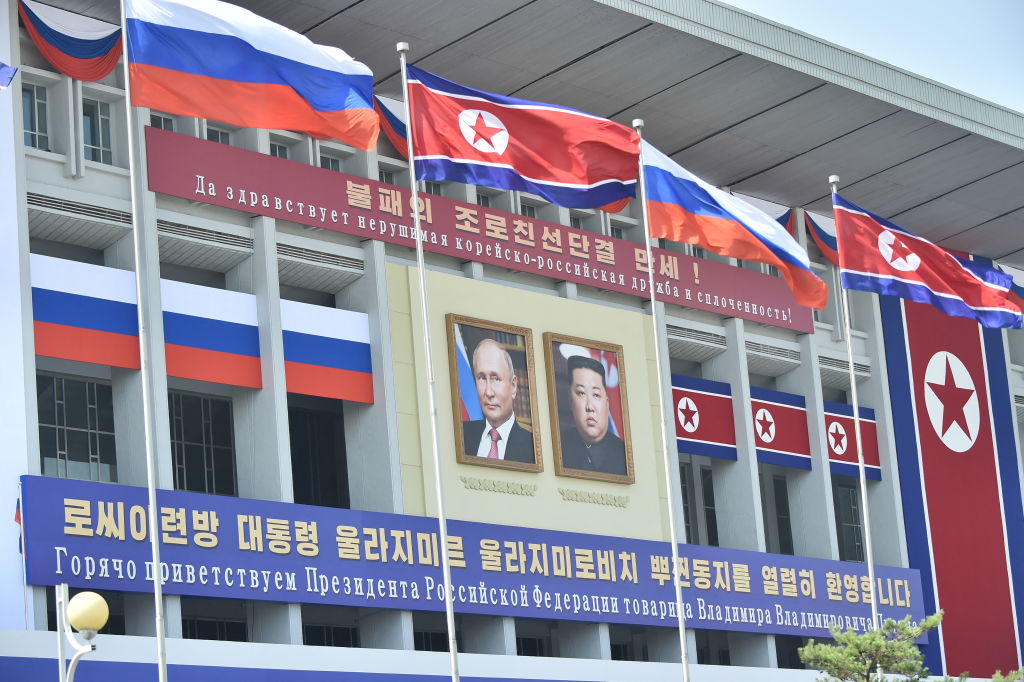North Korea has sent about 15,000 troops to fight alongside Russia in Ukraine. A new alliance between the countries was struck in at a Pyongyang summit in June 2024. AFP/GETTY IMAGES
THE WATCH STAFF
An estimated 15,000 North Korean troops engaged in their first combat with Ukrainian forces in November 2024. South Korea’s spy agency confirmed the first fighting by North Korean forces in the Kursk region of Russia, according to USA Today. The new military alliance between North Korea and Russia faces considerable obstacles, including untested and possibly ill-trained North Korean troops and a lack of any tradition of logistical and military coordination between the countries. Military experts have cast doubt on whether North Korea’s support will make a difference on the battlefield, but they say the alliance between the two autocratic states signals another threat to NATO’s eastern flank.
Pyongyang’s decision to send the economically ravaged and politically isolated country’s best-trained troops to fight in a war that a recent report estimates is costing Russia at least 2,000 battlefield deaths a day isn’t likely to change the tide of the war. The troops have been sent to the Kursk region in western Russia, which Ukraine secured this year and continues to hold. The North Korean soldiers have been outfitted with Russian uniforms and arms and trained by Russian officers, but how the training will translate into combat remains in question, according to Task & Purpose, a military affairs news site.
The lack of any tradition of joint training or even basic linguistic capabilities to allow Russian and North Korean troops to coordinate effectively will likely hinder their effectiveness, U.S. and allied officials told the news site. Former NATO Supreme Allied Commander Ret. Navy Adm. James Stavridis, who served at that post between 2009 and 2013, said the North Korean troops could end up as little more than cannon fodder. “To simply throw 10,000 North Koreans on the battlefield will demonstrate how challenging it is to achieve the kind of operational proficiency that NATO has,” Stavridis said. “I don’t think the North Koreans, therefore, are going to make a significant range difference in the fight. Most of them will be thinking about how they can survive in what will appear to them to be a very bewildering war. They will be, quite literally, strangers in a strange land.”
Russia has been cultivating alliances with rogue states across the globe in recent years as the West has condemned its February 2022 invasion of Ukraine, levied sanctions against Moscow and sent billions in aid to Kyiv in its fight to maintain its sovereignty. In June 2024, Russian President Vladimir Putin visited Pyongyang to proclaim a deepening of ties between the two nations. North Korea has violated international norms for decades, most importantly in its development of nuclear weapons and its supply of weapons to terrorists and to nations like Iran that support terrorism. At the June summit, Putin and North Korean leader Kim Jong Un reached a “comprehensive partnership agreement” that included a clause where they agreed to provide “mutual assistance in the event of aggression” against either country, according to the BBC. Western security officials believe North Korea will receive Russian technical assistance in weapon system development as well as other aid in exchange for sending troops to Ukraine.
Although it is believed the troops will be divided into five units of about 3,000 soldiers apiece, they will likely only share common ammunition and small-arms compatibility with their Russian counterparts, Task & Purpose reported. That differs starkly from how strong, operationally effective military alliances work, said several retired U.S. senior military officials. All 32 NATO members must meet a common set of logistical, operational and intelligence standards among other interoperability metrics, said Air Force Gen. (Ret.) Philip Breedlove, the head of U.S. European Command and Supreme Allied Commander Europe of NATO Allied Command Operations from 2013 to 2016. “This, in turn, drives commonality and compatibility of equipment, because if you’re going to work alongside another nation but your radios don’t talk on NATO-standard frequencies, then you’re not going to be a part of what NATO does,” Breedlove told Task & Purpose. “Everything we do in NATO drives everyone to the same set of operating standards and operating compatibility when it comes to kit.”

